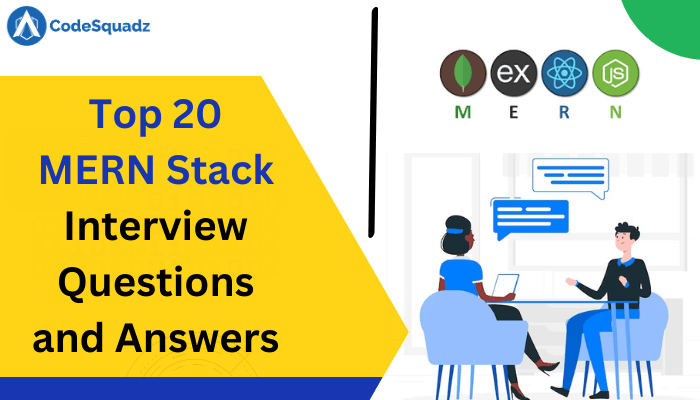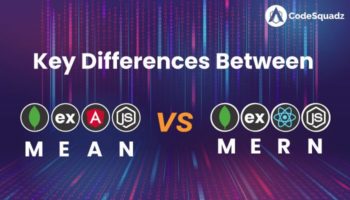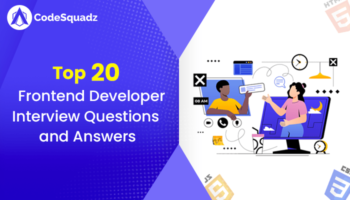MERN is one of the famous technology stacks for web application development. MERN stack developers are in high demand today as they can build a robust and dynamic web application that provides a superior UX.
If you are a fresher and experienced preparing for an interview for the post of MERN stack developer, this blog will help you by providing 10 common interview questions and answers for MERN Stack for each fresher and experienced candidate.
MERN Stack Developer Interview Questions and Answers for Fresher Candidates
Q.1. What is the MERN Stack?
MERN Stack is a collection of 4 technologies (MongoDB | Express.js | React.js | Node.js). This technology stack enables a developer to build a web app quickly. One of the primary functions of this stack is a virtual DOM to improve the performance of a web app.
Q.2. What is the role of MongoDB in MERN?
MongoDB is a popular open-source document database, and it can store data in JSON-like documents to properly store complex data. MongoDB has another advantage in that it has an in-built support for cloud environments. With the help of MongoDB, a developer can modify or even sometimes remove the document properties within a collection.
Q.3. How Does React.js Work?
ReactJS has a declarative JavaScript framework to create a dynamic and it allows a developer to create dynamic client-side applications in HTML. This JavaScript library helps a developer build eye-catching user interfaces and has a component-based architecture to encourage code reusability.
Q.4. What are React Hooks?
Hooks is a newly launched feature in React and it allows a developer to use state and other features without any need to write a class. If follows two rules:
– Only Call Hooks at the Top Level
– Only Call Hooks from React Functions
Q.5. What is Callback Hell?
Callback hell is a condition in which a development nests multiple callbacks within a specific function. Here, the shape of the deformed code resembles a pyramid, therefore, it is also known as the “Pyramid of the Doom” because it makes it difficult for a developer to properly maintain the code and understand it.
Q.6. What are the advantages of React.js?
Here are some of the best advantages of React.js that a developer enjoys.
- React.js is much easier to learn, maintain, and use
- Create dynamic apps with less coding
- Provide multiple reusable components
- Offer a scope where the developer can test the codes
- Comes with strong community support
- React.js is rich in terms of both packages & extensions
- React has amazing JavaScript support
Q.7. What’s the purpose of Express.js?
Expres.js is a web app development framework to support the Node.js projects. It is one of the best open-source frameworks that manages the flow between the front end and the database.
Q.8. What is a React Key?
In React.js, a key is one of the unique identifiers and is useful for a developer to learn which items are modified or deleted from the lists.
Q.9. What is the concept of Virtual DOM in React.js?
Virtual DOM (VDOM), a programming concept, is the representation of actual DOM and React uses it to update & render its components by minimizing the direct manipulation of the actual DOM.
Q.10. What is JSX in React?
JSX (JavaScript Extension) is a React extension that is famous for allowing developers to write JavaScript codes that appear like HTML codes.
MERN Stack Developer Interview Questions and Answers for Experienced Candidates
Q.1. What is a thread pool and which library handles it in Node.js?
As the name suggests, the thread pool is the pool of threads used in Node.js to offload tasks that require substantial time commitment and ensure that the main thread is not blocked for a longer time. In Node.js, the Libuv library handles it.
Q.2. What is the difference between Virtual DOM and Shadow DOM?
Here are the key differences between Virtual and Shadow DOM.
| Virtual DOM | Shadow DOM |
|---|---|
| Related to solving the performance issues | Related to the encapsulation of DOM and CSS within a specific element |
| It neither isolates the Document Object Model (DOM) nor assists in CSS scoping | It isolates the Document Object Model (DOM) and doesn’t assist in CSS scoping |
| It is a representation of actual DRM | It is not a complete representation of the actual DRM |
| Used in single-page applications (SPAs) | Used for creating web components |
Q.3. What are Higher Order Components (HOCs) in React.js?
Higher-Order Component is a pattern that is useful for code reusability and logic sharing. This function accepts a component to create another component known as a Higher-Order Component. These HOCs are useful for reasoning, props manipulation, bootstrap abstraction, etc.
Q.4. What is prop drilling and how you can avoid it?
In React.js, prop drilling refers to the process of passing the dedicated data through multiple levels of nested components which can make a code less maintainable and harder to read. A developer can avoid it through Component Composition, State Management Library, and React’s Context API.
Q.5. What is aggregation in MongoDB?
In MongoDB, aggregation is a powerful operation that enables a developer to transform the data stored in database collection. In MongoDB, the aggregation framework uses a pipeline-based approach to transform data.
Q.6. How can you ensure secure communication between the components of a MERN application?
Securing communication between components of a MERN application can be completed using HTTPS Encryption, Authentication and Authorization, Secure API Endpoints, Secure Cookies and Sessions, etc.
Q.7. What is CORS (Cross-Origin Resource Sharing), and how do you deal with it in a MERN application?
CORS (Cross-Origin Resource Sharing) is an important security feature for browsers to manage web apps running at one domain from making requirements to various domains. A developer can easily deal with CORS in a MERN application using server-side configuration, handling preflight requests, front-end configuration, etc.
Q.8. What tools and technologies can you use for testing a MERN application, both on the front-end and back-end?
Undeniably, testing of both Front-end and Back-end is important and there are various tools and technologies available to complete this task. Below is the list of these tools and technologies.
Front-end Testing: Jest | React Testing Library | Enzyme | Cypress
Back-end Testing: Mocha | Chai | Supertest | Postman
Q.9. Describe the process of deploying a MERN application to a production server.
Here are the notable steps for deploying a MERN app to ensure that your application is accessible, performant, and secure.
- Do prepare your application for deployment and select a hosting provider.
- Set up a server and install any necessary software by installing Node.js, and MongoDB.
- Set up firewalls to secure the server and upload back-end code to the server.
- Deploy the front-end by building your React application for the product using a build tool like Create React app
- Set up monitoring and alerting for your application and implement regular backups.
Q.10. Explain the differences between SQL and NoSQL databases, and when would you prefer one over the other in a MERN project?
Both SQL and NoSQL are broad categories and you can choose any one of them for your MERN project by knowing the proper difference between them.
| SQL | NoSQL |
| These databases are table-based | These databases can be object-oriented or graph-structured |
| Vertical Scalability | Horizontal Scalability |
| Use SQL | Use JSON |
| Support is available through various database systems | Support is not available through various database systems |
Conclusion
These are some of the most asked MERN Stack interview questions and answers. Designed and developed by subject matter experts, this will help you to prepare and crack your interview in IT companies at a handsome salary package.







